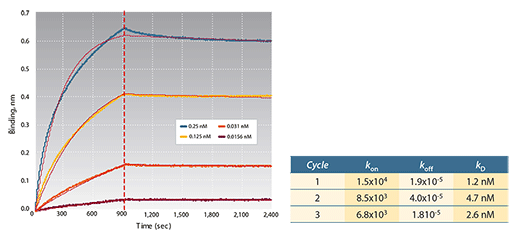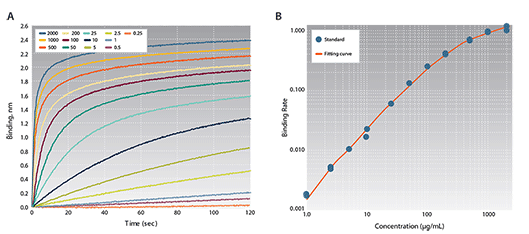For Quantitation and Kinetic Characterization of GST-tagged Biomolecules
Glutathione-S-transferase (GST) is commonly fused to recombinant proteins to facilitate detection and purification, and to increase solubility. The anti-GST biosensor consists of a high affinity anti-GST antibody pre-immobilized on a ForteBio biosensor. In conjunction with the Octet System, the anti-GST biosensor provides a rapid and label-free method for GST-tagged protein quantitation and kinetic analysis. The high specificity of the antibody-based biosensor enables the direct quantitation of GST analytes in crude lysates, column eluents, cell lysates and cell culture supernatants, serving as an alternative to traditional time-consuming analytical methods.
Learn more:
Download
.
Key Features
- Direct and rapid quantitation of GST-tagged biomolecules
- Easy and reliable capturing of GST-tagged biomolecules for rapid kinetic analysis
- Designed for use in buffer or complex media

Figure 1: Kinetic analysis of the interaction between GST-Protein A (65 kDa) and an interaction partner Protein B (40 kDa). 10X kinetics buffer was used as the matrix throughout and the assay temperature was 30°C. A single column of biosensors was used to collect three datasets with regeneration using glycine pH 1.7 between cycles (cycles 2 and 3 not shown). Data for cycles 1–3 were processed and curve fit using a 1:1 binding model. The kinetic results for cycles 1–3 are reported in the table.

Figure 2: Detection of a Ubiquitin-GST standard using anti-GST biosensors on the Octet RED384 system with assay parameters for a standard dynamic range (A) and high sensitivity dynamic range (B). A) Assay run at 400 rpm and 2 minutes read time. B) Assay run at 1000 rpm and 2 minutes read time. Sample diluent was used as a matrix for all samples.
For More Information
Visit our literature page to download technical notes, application notes, posters and customer presentations.